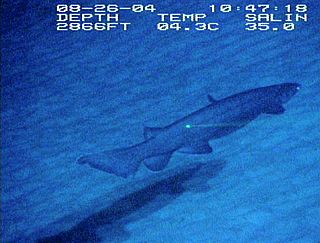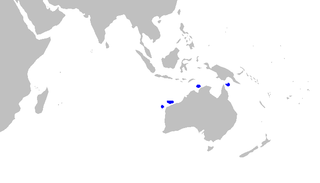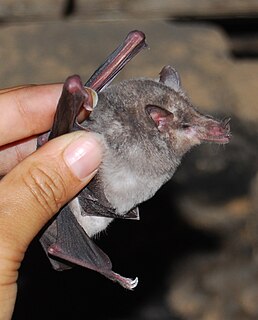
A sawshark or saw shark is a member of a shark order bearing a unique long, saw-like rostrum edged with sharp teeth, which they use to slash and disable their prey. There are eight species within the Pristiophoriformes, including the longnose or common sawshark, shortnose sawshark, Japanese sawshark, Bahamas sawshark, sixgill sawshark, African dwarf sawshark, Lana's sawshark and the tropical sawshark.

The North Sulawesi babirusa is a pig-like animal native to Sulawesi and some nearby islands in Indonesia. It has two pairs of large tusks composed of enlarged canine teeth. The upper canines penetrate the top of the snout, curving back toward the forehead. The North Sulawesi babirusa is threatened from hunting and deforestation.

The whitefin dogfish is a species of deep-sea dogfish shark in the family Etmopteridae. It has only been found in the northwest Pacific Ocean off the southeastern coast of Japan, between the latitudes of 35 and 32°N. It inhabits continental slopes and seamounts at a depth of 320 to 1,100 m. Reproduction is ovoviviparous. It is of no interest to fisheries and almost nothing is known of its biology. The specific epithet ritteri is in honor of Dr. William Emerson Ritter of the University of California.

The southern African frilled shark is a species of shark in the family Chlamydoselachidae, described in 2009. It is found in the deep waters off southern Angola to southern Namibia. This species is difficult to distinguish from the better-known frilled shark, but is smaller at maturity and differs in several proportional measurements including head length and mouth width. It seems to be a specialized predator of smaller sharks, using its flexible jaws and numerous needle-like, recurved teeth to capture and swallow them whole. Reproduction is presumably aplacental viviparous, as with the other member of its family.

The slender sawtail catshark is a little-known species of catshark, part of the family Scyliorhinidae, endemic to northern Australia. It is found over the continental slope in 290–470 m (950–1,540 ft) on water. Growing to 34 cm (13 in) long, this shark has a slim gray body with four dark saddle markings below the dorsal fins and on the caudal fin, as well as a prominent crest of enlarged dermal denticles along the dorsal edge of the caudal fin. The slender sawtail catshark is not valued by fisheries but is taken as bycatch. The International Union for Conservation of Nature (IUCN) presently lacks enough information to assess its conservation status.

The Australian angelshark is a species of angelshark, family Squatinidae, found in the subtropical waters of southern Australia from Western Australia to New South Wales between latitudes 18°S and 41°S, at depths down to 255 m (840 ft). Its length is up to 1.52 m (5 ft). Reproduction is ovoviviparous, with up to 20 pups in a litter.

The West African slender-snouted crocodile is a critically endangered species of African crocodile. It is one of five species of crocodile in Africa, the other four being the Central African slender-snouted, Nile, West African and dwarf crocodiles.

Physalaemus deimaticus is a species of frog in the family Leptodactylidae. It is endemic to Brazil and only known from its type locality in Jaboticatubas, Serra do Cipó, Minas Gerais. The specific name deimaticus is derived from Greek deimos fror "fear" and refers to the defensive display of this frog, probably aimed at scaring predators. Common names Jaboticatubas dwarf frog and frightening foam froglet have been coined for it.

The short-snouted elephant shrew or short-snouted sengi is a species of elephant shrew in the family Macroscelididae. It is found over a wide area of Africa. Its natural habitats are dry savanna and subtropical or tropical dry lowland grassland.

The long-snouted bat is a species of bat in the family Phyllostomidae. It is monotypic within the genus Platalina. It is endemic to northern Peru and northern Chile. It feeds almost exclusively on the nectar and fruit of the columnar cactus. The species is rare, but has a wide distribution with at least 25 populations, and is listed as near-threatened due to habitat loss causing the removal of their primary food source.
The whitefin swellshark is a little-known species of catshark, belonging to the family Scyliorhinidae, endemic to southeastern Australia. It is found 126–554 m (413–1,818 ft) down, on the outer continental shelf and upper continental slope. Reaching 1.1 m (3.6 ft) in length, this shark has a very thick body and a short, broad, flattened head with a large mouth. It is characterized by a dorsal color pattern of dark saddles and blotches over a brown to gray background, and light fin margins. When threatened the whitefin swellshark can inflate itself with water or air to increase its size. Reproduction is oviparous. As of 2019 The International Union for Conservation of Nature(IUCN) has assessed this species as Critically Endangered due to the significant decline of the population.
The saddled swellshark is a rare species of catshark, and part of the family Scyliorhinidae, endemic to Eastern Australia. This bottom-dwelling species is found on the outer continental shelf and upper continental slope at a depth of 115–605 m (377–1,985 ft). It is a robustly built shark with a short, broad, flattened head and a capacious mouth. Adults are patterned with saddles on a brownish or grayish background, which varies between tropical and temperate sharks; juveniles are light-colored with many spots. This shark reaches 74 cm (29 in) in length. Like other swellsharks, it can inflate itself as a defensive measure. Reproduction is oviparous.
The speckled swellshark is a little-known species of catshark, and part of the family Scyliorhinidae, endemic to the waters off northwestern Australia. It occurs on the outer continental shelf and upper continental slope, at a depth of 150–455 m (492–1,493 ft). This species grows to 69 cm (27 in) long and has a stocky body and a short, broad, flattened head. As its common name suggests, its color pattern consists of many dark spots and white-spotted dark saddles and blotches on a light gray background. The juveniles are yellow with dark spots and lines, and a distinctive eyespot-like mark behind each eye. Like other swellsharks, this species can inflate itself as a defensive measure.
The yellow shovelnose stingaree is a little-known species of stingray in the family Urolophidae, endemic to the outer continental shelf off Western Australia at a depth of 100–210 m (330–690 ft). Growing to 39 cm (15 in) long, this species has an oval pectoral fin disc with a rather elongated, triangular snout, and a short tail with a caudal fin but no dorsal fin. There are prominent lobes outside of its nostrils, and a skirt-shaped flap of skin with a deeply fringed trailing margin in between. Above, this ray is an almost completely uniform light to dark yellow color, which darkens on the caudal fin. The International Union for Conservation of Nature (IUCN) assesses the yellow shovelnose stingaree as least concern, as there is minimal fishing within its range.

Tasmanipatus anophthalmus, the blind velvet worm, is a species of velvet worm in the family Peripatopsidae. The species is listed as Endangered on the IUCN Red List.

Ansell's epauletted fruit bat is a species of megabat in the family Pteropodidae.
The painted swellshark is a little-known species of catshark, belonging to the family Scyliorhinidae, found in eastern Indonesia. This species reaches a maximum known length of 72 cm (28 in), and has a thick body with a short, broad and flattened head. It is dark gray with a variegated pattern of irregular darker and lighter blotches above, and lighter below with gray blotches and speckling on the snout. Like other swellsharks, it can inflate itself as a defensive measure.

The bighead spurdog is a rare and little-known species of dogfish shark in the family Squalidae. It is found in deep water south of New Caledonia, and over the Norfolk Ridge. Reaching at least 90 cm (35 in) in length, this stocky shark is brown above and light below, with a broad head and two dorsal fins with long spines. It is the only member of its genus with both one- and three-pointed dermal denticles. An infrequent bycatch of longline fisheries, this species is listed under Data Deficient by the International Union for Conservation of Nature (IUCN).
The starry catshark is a species of fish in the family Scyliorhinidae found in New Caledonia.
The narrowhead catshark is a catshark of the family Scyliorhinidae. This species is described based on one adult and one juvenile male specimen from off Tanzania and Mozambique in the western Indian Ocean. The species differs from its congeners by its slender head and snout, which is only slightly bell-shaped in dorsoventral view without distinct lateral indention. It further differs from B. clevai by attaining a smaller maximum size and having a color pattern of fewer and smaller blotches, larger oral papillae, a shorter snout, and broader claspers without knob-like apex and with a smaller envelope and a subtriangular exorhipidion. Compared to B. hispidus, the species has a longer snout, a longer dorsal-caudal space, broader clasper without knob-like apex, and fewer vertebral centra. In contrast to B. lutarius, B. tenuicephalus attains a smaller size and has a blotched coloration, numerous oral papillae, shorter anterior nasal flaps, a longer caudal fin, a shorter pelvic anal space, and shorter and broader claspers.













